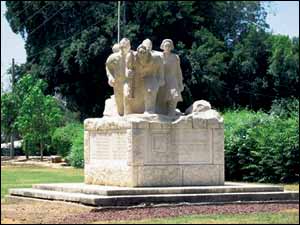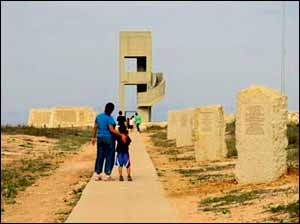 | ||
| Kibbutz cowboy never returned from war | ||
ALMOST two-and-a- half-thousand Israeli soldiers died in the devastating Yom Kippur War, 11 of whom were from Kibbutz Beit Hashita.
Uri Arbel was a member of a veteran Jezre’el Valley kibbutz and a reservist in the IDF who dropped everything when called up — and was killed in Sinai. He was listed as missing for weeks before his body was found and returned to Israel for burial. Uri was an extremely charismatic man, general secretary of the kibbutz when the war broke out. Before taking up the position of general secretary, a post usually undertaken for three years, Uri was a cowboy and spent most of his day riding a horse around the mountains where the kibbutz beef herd wandered or repaired broken fences out on the range. He appeared in the film Rami and the Porcupine and a popular children’s book published around the film’s storyline. All the children and adults who appeared in both book and film were from his kibbutz community, most of the children now grandparents or buried in the kibbutz cemetery. A son was born to Uri and his wife around the same time as that of my first born child. Both boys were together in the baby house and in the toddlers group. My son’s father, a tank commander, returned from Sinai and the crossing of the Suez Canal. But tragically, Uri did not and his son, Itamar, became an orphan before his third birthday. The Jezre’el Valley, nowadays one of the most fertile regions in Israel, is testament to the strength and determination of the early 1900s pioneers who drained mosquito ridden swamps, toiled sodden soil, built successful agricultural and other communities, planted hundreds of thousands of trees and so much more. The valley is also testament to the heavy price they paid in defending those communities against Arab attackers before and during the 1948 War of Independence and subsequent decades. Almost every Jezre’el Valley community founded either before or after 1948, sadly have in-house memorials to those in their own community who died serving the country. At Beit Hashita in the eastern portion of the valley, a number of memorials, some created from metal tank tracks and other pieces of broken, twisted military equipment, a poem or quote embedded in a rock, are omnipresent and testament to the loss of so many of their fathers, sons, brothers and husbands who died in 1973.
One memorial, perched atop the Menashe Hills, across the valley floor from Beit Hashita and overlooking the whole valley, is dedicated to the thousands of members of kibbutzim from all over the country who became casualties of the Arab-Israel conflict. A large number of them were from Jezre’el Valley agricultural communities and the valley towns of Yokne’am, Tivon, Migdal HaEmek and Afula. At the impressive Menashe Hills kibbutz memorial on the cusp of the valley, the names of each of the fallen are engraved on large stone walls placed alongside a huge concrete built watchtower overlooking the valley below. From this site, on a clear winter’s day, it is possible to see the Golan Heights and snow-capped Mt Hermon and into the West Bank to the Palestinian Authority town of Jenin. One of the most powerful of the memorials in the valley is situated in the central square of the 1927-founded Kfar Yehoshua, named after Yehoshua Hankin, who, on behalf of the Jewish people and working for the Yeshuv, purchased huge tracks of land in the Jezre’el Valley. Standing tall and proud alongside the original watertower of the moshav, sculpted from a gigantic piece of white rock, the memorial sits on a raised platform of paving stones, surrounded by an abundance of greenery, the work of the highly-veered Israeli sculptress Batia Lichansky. The memorial depicts four armed men and one woman, half bent over, heads thrust forward and so close together they seem almost to be one. A strong message of together we stand, divided we fall, emanates from this particularly gripping memorial — a message that seems to be ignored by so many Israelis in present times as Israeli society becomes more and more divided.
|
 TRIBUTE: Memorial of the Kibbutzim on the Menashe Hill
TRIBUTE: Memorial of the Kibbutzim on the Menashe Hill SACRIFICES: Kfar Yehoshua memorial by Batia Lashinsky honouring those who died in 1948
SACRIFICES: Kfar Yehoshua memorial by Batia Lashinsky honouring those who died in 1948